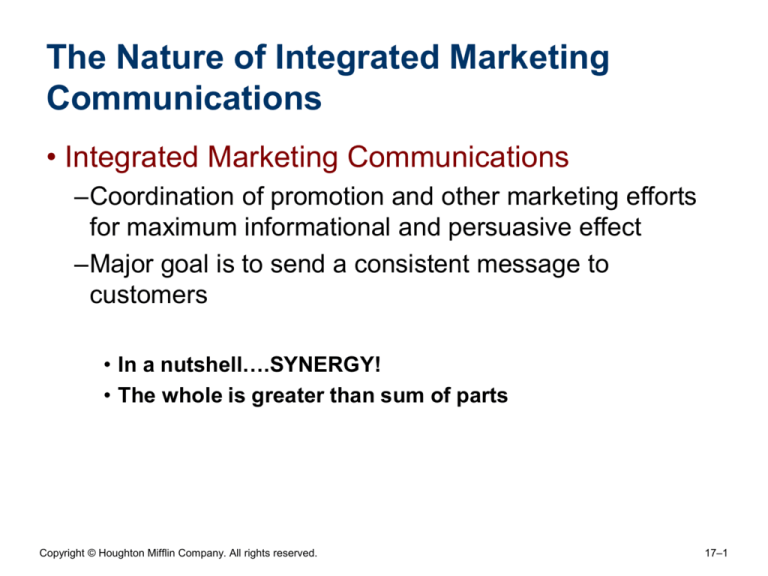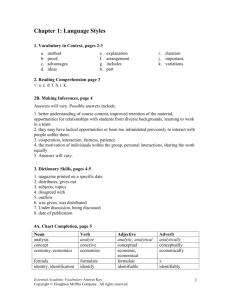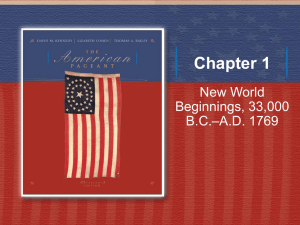
The Nature of Integrated Marketing
Communications
• Integrated Marketing Communications
–Coordination of promotion and other marketing efforts
for maximum informational and persuasive effect
–Major goal is to send a consistent message to
customers
• In a nutshell….SYNERGY!
• The whole is greater than sum of parts
Copyright © Houghton Mifflin Company. All rights reserved.
17–1
The Nature of Integrated Marketing
Communications (cont’d)
• Integrated Marketing Communications (cont’d)
–Reasons for acceptance of integrated communications
• Decreased use of mass media advertising
–Fragmented audiences, cable, internet
• Database marketing provides more precise targeting of
customers
–Amazon.com, Build-a-Bear!
• More broadly diversified suppliers of advertising
• Increased management demands for returns on
investments in marketing efforts
–How do you measure advertising?
Copyright © Houghton Mifflin Company. All rights reserved.
17–2
The Role of Promotion
• Promotion
–Communication to build and maintain relationships by
informing and persuading one or more audiences
–Overall role of promotion is to stimulate demand by
• building and enhancing customer relationships.
• focusing customers on information about company
activities and products.
• promoting programs that help selected groups to build
goodwill.
• sponsoring special events that generate positive
promotion of an organization and its brands.
Copyright © Houghton Mifflin Company. All rights reserved.
17–3
The Communication Process
FIGURE 17.2
Copyright © Houghton Mifflin Company. All rights reserved.
17–4
Objectives of Promotion
• Create Awareness
–Is crucial to initiating the product adoption process
–Helps generate revenues to recoup R&D costs
–Refresh interest in existing brands and products
• Stimulate Demand
–Primary demand is demand for a product category
rather than for a specific brand
• Cheese, milk, RV’s
–Pioneer promotion is promotion that informs consumers
about a new product
• New recordable DVD’s
–Selective demand is demand for a specific brand
• Kraft cheese
Copyright © Houghton Mifflin Company. All rights reserved.
17–5
Objectives of Promotion (cont’d)
• Encourage Product Trial
–Distributing product samples fosters consumer
evaluation of a product.
• Dryel? Flop. New Woolite Dark? Boca Burgers?
• Identify Prospects
–Customer-response promotions generate sales leads.
• Salespeople can get leads from internet inquiries
• Retain Loyal Customers
–Frequent-user programs reward loyal customers.
• Frequent flyers, kroger smart cards
• Facilitate Reseller Support
–Advertising by producers promotes sales for resellers.
• Co-op advertising (Clinique at Goldsmiths)
Copyright © Houghton Mifflin Company. All rights reserved.
17–6
Objectives of Promotion (cont’d)
• Combat Competitive Promotional Efforts
–Promotions countering competitors’ own promotions
–Pepsi Twist vs. Coke Lemon?
–Miller Lite vs. Michelob Ultra
• Reduce Sales Fluctuations
–Promotion raises sales in off-peak sales periods.
• Matinee prices
Copyright © Houghton Mifflin Company. All rights reserved.
17–7
The Four Possible Elements of a
Promotion Mix
• Promotion Mix
–A combination of promotional methods used to promote
a specific product
FIGURE 17.3
Copyright © Houghton Mifflin Company. All rights reserved.
17–8
The Promotion Mix
• Advertising
–A paid nonpersonal communication about an
organization and its products transmitted to a target
audience through mass media
–Benefits
• Extremely cost efficient (cost per person) in reaching a
large audience
• Repeatable several times and in several media markets
• Adds value to a product and enhances a firm’s image
• Great awareness tool
Copyright © Houghton Mifflin Company. All rights reserved.
17–9
The Promotion Mix (cont’d)
• Personal Selling
–A paid personal communication that seeks to inform
customers and persuade them to purchase products in
an exchange situation
–Advantages
• Is a more specific form of advertising
• Has greater impact on consumers
• Provides immediate feedback
–Limitations
• Is an expensive form of advertising
• Is labor intensive and time consuming
• Human factor?
Copyright © Houghton Mifflin Company. All rights reserved.
17–10
The Promotion Mix (cont’d)
• Public Relations
–A broad set of communication efforts used to create
and maintain favorable relationships between the
organization and its stakeholders (I.e., the public,
press, stockholders, etc.)
–Publicity is a nonpersonal communication in a news
story form about an organization or its products, or
both, transmitted through a mass medium for free
• It’s sometimes the result of PR Efforts
• Other times? Not controlled!
Copyright © Houghton Mifflin Company. All rights reserved.
17–11
The Promotion Mix (cont’d)
• Sales Promotion
–An activity or material that acts as a direct inducement,
offering added value or incentive for the product, to
resellers, salespeople, or consumers
• Giving an INCENTIVE to by sooner!
Copyright © Houghton Mifflin Company. All rights reserved.
17–12
Selecting Promotion Mix Elements
• Word-of-mouth communication has a strong
impact on consumers’ buying proclivities.
–Buzz marketing and viral advertising are marketers’
attempts to take advantage of word-of-mouth
communications
–Buzz marketing is an attempt to create a trend or
acceptance of a product through word-of-mouth
• IKEA, Truth campaign, Harry Winston jewelers
–Viral marketing is a strategy to get users of the Internet
to pass on ads and promotions to others.
–http://freeflixtix.com/splash.html
• http://www.planetfeedback.com/
Copyright © Houghton Mifflin Company. All rights reserved.
17–13
Selecting Promotion Mix Elements
(cont’d)
• Promotion Resources, Objectives, and Policies
–A limited promotional budget affects the number and
types of promotion mix components affordable to a firm.
–Objectives and policies influence the types of
promotion selected.
• Characteristics of the Target Market
–Market size, geographic distribution, and
demographics help dictate the choice of
promotion mix elements.
• Rural vs. metropolitan
• Blue vs. white collar
Copyright © Houghton Mifflin Company. All rights reserved.
17–14
Selecting Promotion Mix Elements
(cont’d)
• Characteristics of the Product
Method
Product
Personal
Selling
Business products
Consumer durables
Exclusive distribution, high-priced products
Late life-cycle business products
Advertising
Consumer goods
Seasonal products
Highly personal products
Intensively distributed, low-priced convenience items
Early life-cycle products
Mature life-cycle consumer nondurables
Copyright © Houghton Mifflin Company. All rights reserved.
17–15
Push and Pull Channel Policies
• Push Policy
–Promoting a product only to the next institution down
the marketing channel
• Example: Giving retailers point-of-purchase displays to
help push product to consumers.
• Pull Policy
–Promoting a product directly to consumers to develop
stronger consumer demand that pulls products through
the marketing channel
• So consumers can ask retailers
• Pulling it thru channel
Copyright © Houghton Mifflin Company. All rights reserved.
17–16
Criticisms and Defenses of Promotion
• Is Promotion Deceptive?
• Does Promotion Increase Prices?
• Does Promotion Create Needs?
• Does Promotion Help Customers Without Costing
Too Much?
• Should Potentially Harmful Products Be
Promoted?
Copyright © Houghton Mifflin Company. All rights reserved.
17–17


